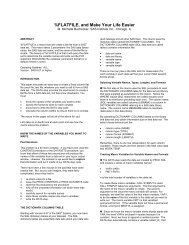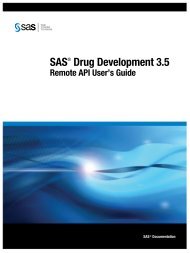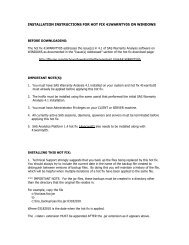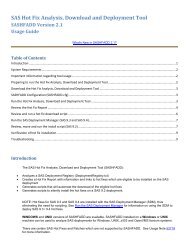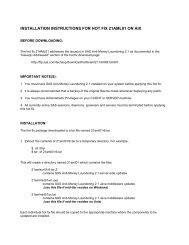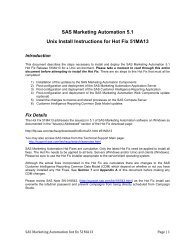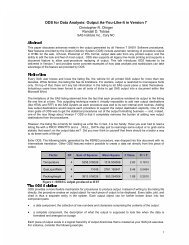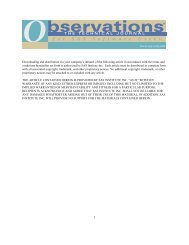SAS 9.3 Web Applications: Clustering - Index of - SAS
SAS 9.3 Web Applications: Clustering - Index of - SAS
SAS 9.3 Web Applications: Clustering - Index of - SAS
Create successful ePaper yourself
Turn your PDF publications into a flip-book with our unique Google optimized e-Paper software.
24 Chapter 3 / JBoss <strong>Clustering</strong><br />
3. Another alternative is to deploy high-availability JMS resources. See JBoss<br />
documentation for information about JMS and high availability.<br />
Configure Start-Up Scripts<br />
1 In the JBOSS_HOME\bin directory, copy <strong>SAS</strong>Server1.bat to <strong>SAS</strong>Server2.bat.<br />
2 Edit <strong>SAS</strong>Server2.bat and make the following changes:<br />
a Change all instances <strong>of</strong> <strong>SAS</strong>Server1 to <strong>SAS</strong>Server2.<br />
b Change the value for the following JVM options:<br />
-Dsas.auto.publish.port=8180<br />
-Dsas.scs.port=<br />
-Dsas.scs.host=<br />
Set the -Dsas.scs.port and -Dsas.scs.host JVM options to use the <strong>SAS</strong><br />
Content Server instance that you selected in “Reconfigure the <strong>SAS</strong> Content<br />
Server Repository” on page 7.<br />
c Add the following JVM options:<br />
-Dsas.appserver.instance.id=<strong>SAS</strong>Server2<br />
-Dsas.wrs.keyUserActionLog.path=<br />
c:\<strong>SAS</strong>\Config\Lev1\<strong>Web</strong>\Logs\<strong>SAS</strong>Server2<br />
Also add this parameter to each server instance, using the appropriate server<br />
instance ID value. This value is used by <strong>SAS</strong> Content Server and in logging.<br />
d For UNIX deployments, change the port number that is used in the stop<br />
target. For <strong>SAS</strong>Server2, the typical value is 1199:<br />
stop)<br />
# add args for username/password as in "<strong>SAS</strong>Server2.sh stop -u username...<br />
JAVA_OPTS="-d64 -Xms512M -Xmx512M"<br />
"JBOSS_HOME/bin/shutdown.sh" -s localhost:1199 $* -S<br />
e Set the values for any other JVM parameters that are specific to your <strong>SAS</strong><br />
middle-tier topology.<br />
On Windows operating systems, the default configuration for JBoss is to run as a<br />
service. The service configuration is set in JBOSS_HOME\server<br />
\<strong>SAS</strong>Server2\wrapper.conf. If you plan to run JBoss as a Windows service,<br />
then edit the wrapper.conf file and make all the changes that you set in the previous<br />
step. For example, change all instances <strong>of</strong> <strong>SAS</strong>Server1 to <strong>SAS</strong>Server2, and change<br />
the value for the -Dsas.auto.publish.port parameter to the new HTTP port. On all the<br />
machines except the machine that is running <strong>SAS</strong> Remote Services, remove the<br />
wrapper.ntservice.dependency entries. After the edits are complete, create the<br />
service entry as shown in the following example:<br />
<strong>SAS</strong>Server2.bat -install<br />
The outcome at this point is a series <strong>of</strong> JBoss servers that are configured to run on<br />
unique ports. At least one JBoss server instance is configured as a stand-alone<br />
server with the <strong>SAS</strong> BI Dashboard Event Generator and any applications that you<br />
prefer not to cluster. Some <strong>of</strong> the JBoss servers have identical deployments <strong>of</strong> the





